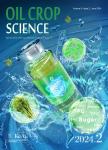Gene transformation by in situ pistil delivery method in Brassica
Gene transformation by in situ pistil delivery method in Brassica作者机构:Key Laboratory of Biology and Genetic Improvement of Oil Crop Ministry of Agriculture Oil Crop Research Institute Chi-nese Academy of Agriculture Sciences Wuhan China
出 版 物:《Oil Crop Science》 (中国油料作物学报(英文版))
年 卷 期:2016年第1卷第3期
页 面:13-23页
学科分类:09[农学]
基 金:The authors gratefully acknowledge Dr. Mark Smedley (John Innes Centre, Norwich Research Park, Colney, Norwich) for kindly providing the plasmid pGreen0229. We have many thanks for Mr. Yong Cheng for vector construction of pGrGUS, Yuey-ing Liu and Xianhu Fu for their technical assistance. This resea(2016YFD0101007, 2016YFD0100305) Natural High Technology Research and Development Program of China(2013AA102602) National Natural Science Foundation of China (31301039). The funders had no role in study design, data collection and analysis, deci-sion to publish, or preparation of the manuscript. We declare no conflict of interests
主 题:in situ pistil delivery (ISPD) method Brassica genetic transformation free of tissue culture stylar
摘 要:Agrobacterium-mediated gene transformation in Brassica crops is a time-con-suming and labor-cost method (tissue culture and plant regeneration) in a genotype-depen-dent way. Here we described a new method in situ pistil delivery (ISPD) method with no tissue culture and adaptive to three Brassica species. Briefly this method can be stated as placement of a liquid drop containing binary vector DNA onto the cut surface of emasculated and artificial pollinated Brassica stigma. Transformation rate (Basta-resistant seedlings per 100 pistils) of different species ranged from 0.4% to 16.3%. Factors affecting transforma-tion success included timing and buffer type. PCR and Southern blot confirmed transgenic events. Reciprocal cross showed reporter gene steadily inherited in nuclear transformed pattern. GUS histochemical assay of transgenic immature seeds showed stained embroys and endosperm in the same seed, indicating DNA delivered through style and integrated into Brassica seed/genome after double fertilization.



